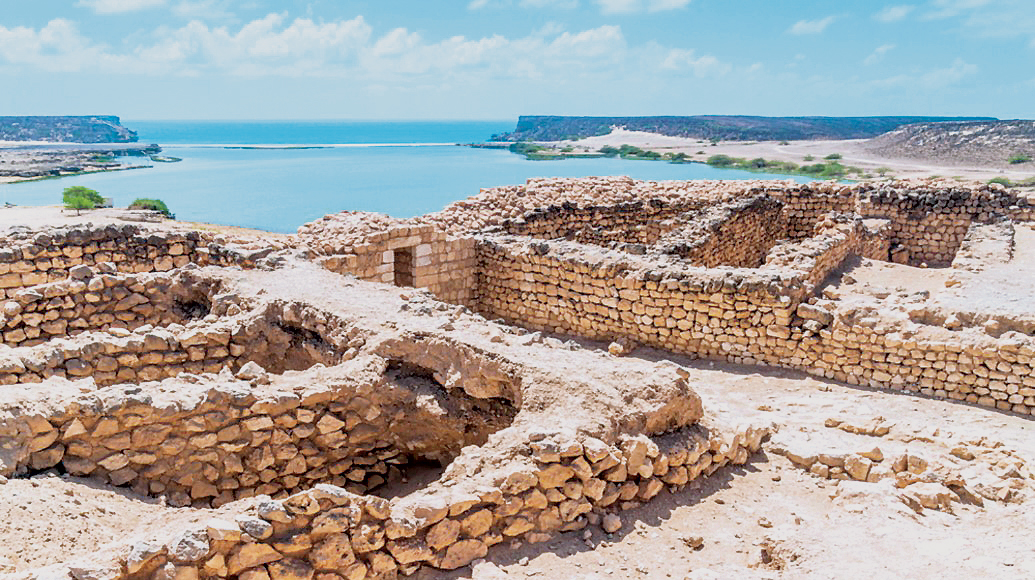

MUSCAT, August 18 - Sumhuram, also known as Khor Rori, is a standing proof of ancient history and Oman’s link to historical trading route, and the adjacent museum is the latest addition that further gives a deeper understanding of the once important harbour in the region. While archaeologists have painstakingly unravelled the structures of this once upon a time thriving town under the supervision of the Office of Adviser to His Majesty Sultan for Cultural Affairs, the UNESCO has included it in the World Heritage List.
Sumhuram (3rd century BC – 5th century AD), built in the area of Khor Rori, is the most important pre-Islamic settlement in the Governorate of Dhofar. Today it is part of the Land of Frankincense Trail and attracts a great number of tourists. The visit to the site introduces one not just to the architecture and script of ancient Dhofar, but also a glimpse to the lifestyle. The information centre at the site gives detailed information of the history and the archaeological findings through films, 3D reconstruction and prints, while the Sumhuram Archaeological Gallery has exhibits of some of the exquisite artefacts discovered at the site.
Trading convoys are known to have travelled from here to Shabwa, Marib, Al Batra and even reaching to the civilisations of Mesopotamia, ancient Egypt, the northern coasts of the Mediterranean Sea, Eastern Indus Valley and China. The Periplus, Greek work of the 1st century AD, described Sumhuram under the Greek name of Moscha Limen — “It stands out as a crucial long-distance trading centre.”
Collection of temples
An intriguing element of the Sumhuram is the gate itself. The monumental gate of Sumhuram opens in the northern side of the city wall looking towards the plain and it was an imposing defensive structure as it was steep and visitors had to go through three successive wooden doors. The zigzag path goes to the town, but just before the entry on the left hand side is the inscription on the stone, now protected by a glass, in the South Arabian text describing the construction of the city. The visitors have to walk through three passages to arrive inside the town. A small door, a postern is on the eastern side of the gate complex.
The town has different sections such as the residential area with many houses along the streets. The most common type of house in Sumhuram has a central corridor with two or three rooms at its sides, used for daily life. On the other hand, there are also facilities for frankincense production – storerooms. While today we see the foundation of most of these rooms, experts point out that the houses in Sumhuram could have had several floors. The upper floors were the living space and ground floors were often operating as artisans’ warehouses. The most impressive structure in the area is the building protecting a well that is 25 m deep.
Another intriguing element is the collection of temples. According to the expert at the site, “The main temple, in the western part of the city, is dedicated to the moon God named Sin. Two staircases led to the entrance of the temple. Its main room was divided in three naves by two rows of column. An area for ablution and public restrooms were adjacent to the temple. Also a small shrine is present in Sumhuram. Yet, another temple is located outside the city near the opening of the lagoon.”
Commercial district
The huge structure located to the south-east of the Sin Temple is one of the most ancient and most impressive buildings in the city of Sumhuram.
The building was used as a large store of food supply, point out the experts of the site, “Probably not for the inhabitants but for the sailors who docked at the port. The faunal remains inside the building reveal significant specificities of animals including camels, bovines, sheep and big fishes. In contrast with the daily-diet of the inhabitants of Sumhuram, this mainly consisted of shells, small fishes and goats. Its northern wall depicts carved scenes of camels and ibexes.”
Another significant area of Sumhuram is the commercial district — the market place — in the south-eastern part of the city, was according to the archaeologists a large rectangular square. Along the northern and southern side of this square archaeologists excavated 11 long rectangular rooms — four to south and seven to north. These were used to store frankincense and other goods. A small door opening in the eastern side of the city wall linked the market place to the port.
But of course there is more to Sumhuram as the reconstruction of Sumhuram Archaeological Park at the information centre details the numerous structures and settlements from the Paleolithic, Neolithic, Bronze, Iron to Medieval Age. The human presence dates on the top of the Inqitat, the eastern rock facing Sumhuram, dates back to Paleolithic period (60,000 years ago). There are also evidences tracing back to late Neolithic, Bronze, Iron and Medieval Ages.
The great quantity of iron and bronze objects discovered as the presence of a workshop for metals, suggested that the city was also a very important centre for internal trade towards southeastern Arabia and the northern coast of Oman, which was rich in copper.
Oman Observer is now on the WhatsApp channel. Click here



